Greer Gilman's Blog, page 76
July 4, 2012
Fire and rain

Didn't get the lightning—I so hope someone did—but I got Loki at play.
Nine
Published on July 04, 2012 20:32
I've seen fire and I've seen rain
A bolt of lightning cleft the fireworks: Thor struck and Loki danced and scattered, rising over and again. A godstorm.
Nine
Nine
Published on July 04, 2012 20:07
June 28, 2012
Trippingly on the tongue
My Readercon schedule. Few but fabulous!
Friday July 13
6:00 PM
Speech Patterns.
Judith Berman, Leah Bobet, Greer Gilman, Sarah Smith (leader), Vinnie Tesla.
Writers can adopt the convention that people in the future (or past) speak just as they do now. Or they can take contemporary speech patterns and tweak them to suggest the different time or place. Or they can go for verisimilitude (historical or imagined). Why do we see more tweaking of speech patterns in stories set in the past than the future? Is altering speech patterns to give a flavor of the future an underused technique, or does it present more difficulties (see Riddley Walker, A Clockwork Orange, or Ambient)? Some writers the altered speech pattern for the aliens reserve, as a way of underscoring their different psychology. What other techniques are available?
7:00 PM
The Literature of Estrangement.
Christopher Brown, Lila Garrott (leader), Greer Gilman, Anil Menon, Jeff VanderMeer, Paul Witcover.
In a 2011 interview in The Guardian concerning the paucity of SF and fantasy texts among Booker nominees (and, we might add, Pulitzers or National Book Awards in the U.S.), China Miéville suggested repositioning the debate as not between the realistic and the fantastic, but between "the literature of recognition versus that of estrangement," though he admitted that "the distinction maps only imperfectly across the generic divide" and that "all fiction contains elements of both drives." Is this a more useful set of terms for discussing the familiar schism? Does it reveal literary alignments in an inventive new way? Or is it simply cutting the same cake at a different angle?
Saturday July 14
10:30 AM
Reading.
Greer Gilman.
Greer Gilman reads from a work in progress, a Jacobean revenge procedural.
Sunday July 15
1:00 PM
Mapping the Parallels.
Greer Gilman, Walter Hunt (leader), Alison Sinclair, Howard Waldrop, Jo Walton.
Stories of parallel worlds are often actually stories of divergent worlds. As such, they contain implicit ideas about how and why divergences can happen: questions of free will and personal choice, theories of history, and speculation about the core constants of the universe. The range of divergences, and the reasons behind them, also serve as at least a partial map of the kinds of possibilities considered worth telling stories about. With this in mind, let's talk about what has been done, or could be, with the idea of parallel worlds in fiction—both classic and contemporary examples in SF&F, women's fiction, MG/YA, and more. How do the differences in usage of the trope—such as the scope of divergence (personal vs. societal vs. scientific, human-centric vs. extra-human), the degree to which the causes of divergence are explained, and the ability to travel between divergent worlds—play out across parallel and divergent world stories? How do they express ideas about what is possible?
Nine
Friday July 13
6:00 PM
Speech Patterns.
Judith Berman, Leah Bobet, Greer Gilman, Sarah Smith (leader), Vinnie Tesla.
Writers can adopt the convention that people in the future (or past) speak just as they do now. Or they can take contemporary speech patterns and tweak them to suggest the different time or place. Or they can go for verisimilitude (historical or imagined). Why do we see more tweaking of speech patterns in stories set in the past than the future? Is altering speech patterns to give a flavor of the future an underused technique, or does it present more difficulties (see Riddley Walker, A Clockwork Orange, or Ambient)? Some writers the altered speech pattern for the aliens reserve, as a way of underscoring their different psychology. What other techniques are available?
7:00 PM
The Literature of Estrangement.
Christopher Brown, Lila Garrott (leader), Greer Gilman, Anil Menon, Jeff VanderMeer, Paul Witcover.
In a 2011 interview in The Guardian concerning the paucity of SF and fantasy texts among Booker nominees (and, we might add, Pulitzers or National Book Awards in the U.S.), China Miéville suggested repositioning the debate as not between the realistic and the fantastic, but between "the literature of recognition versus that of estrangement," though he admitted that "the distinction maps only imperfectly across the generic divide" and that "all fiction contains elements of both drives." Is this a more useful set of terms for discussing the familiar schism? Does it reveal literary alignments in an inventive new way? Or is it simply cutting the same cake at a different angle?
Saturday July 14
10:30 AM
Reading.
Greer Gilman.
Greer Gilman reads from a work in progress, a Jacobean revenge procedural.
Sunday July 15
1:00 PM
Mapping the Parallels.
Greer Gilman, Walter Hunt (leader), Alison Sinclair, Howard Waldrop, Jo Walton.
Stories of parallel worlds are often actually stories of divergent worlds. As such, they contain implicit ideas about how and why divergences can happen: questions of free will and personal choice, theories of history, and speculation about the core constants of the universe. The range of divergences, and the reasons behind them, also serve as at least a partial map of the kinds of possibilities considered worth telling stories about. With this in mind, let's talk about what has been done, or could be, with the idea of parallel worlds in fiction—both classic and contemporary examples in SF&F, women's fiction, MG/YA, and more. How do the differences in usage of the trope—such as the scope of divergence (personal vs. societal vs. scientific, human-centric vs. extra-human), the degree to which the causes of divergence are explained, and the ability to travel between divergent worlds—play out across parallel and divergent world stories? How do they express ideas about what is possible?
Nine
Published on June 28, 2012 14:06
June 21, 2012
Revelry
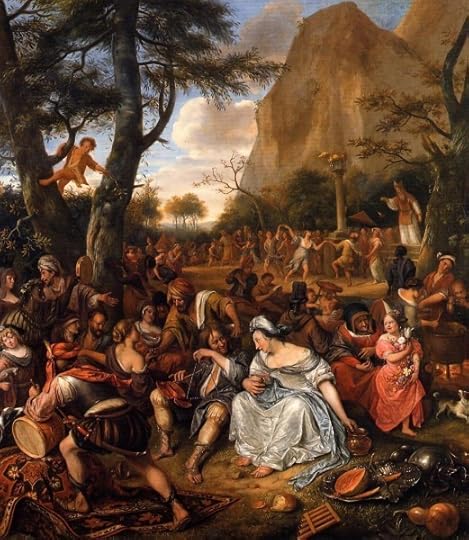
It's a short night. Party fast.
I love the besotted couple in the foreground, the wench with the Pink Lady and the dude with the triangle: "Do me 'Who Put the Bomp.'" "Sure. Backwards?"
Hope yours was a joyful Solstice.
Nine
Published on June 21, 2012 01:34
June 18, 2012
Hierophantic
In the dream, I was pursued up a church tower by a furious Anglican priest—up and round an endless spiral stair into a little whitewashed chamber with a table and a waiting pot of tea, rather stewed. As he burst through the Gothic door, I turned with my mug and said, "I've been bishop for three minutes." And he fell to his knees resentfully, and kissed my hand where the ring would be.
Nine
Nine
Published on June 18, 2012 14:06
June 17, 2012
Crabbed
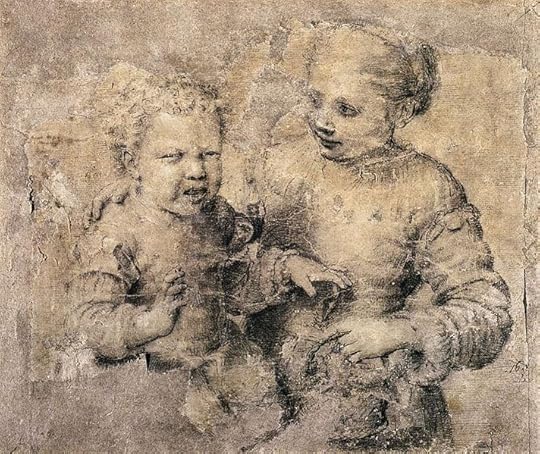
On 20 January 1562, Tommaso Cavalieri sent the grand duke Cosimo de’ Medici two drawings, described by Vasari as “a sketch of Cleopatra from the divine hand of Michelangelo. [And] the other by Sofonisba’s hand, in which a young girl is laughing and a little boy is crying because he put his hand ... into a basket of crabs.”
In his letter Cavalieri writes: “I believe that [Sofonisba’s] may stand comparison with many other drawings, for it is not simply beautiful, but also exhibits considerable invention. ... Michelangelo who had seen a drawing done by her hand of a smiling girl, said that he would have liked to see a weeping boy, as a subject more difficult to draw. After he wrote to her about it, she sent him this drawing, which was a portrait of her brother.”
So the surly old god, dread wielder of the brush and chisel, was setting playful assignments for a girl.
Exalted homework!
Though perhaps Vasari saw (or remembered) a stronger contrast than exists, an allegorical war of genders. The girl here (Minerva) isn't laughing, but ruefully concerned, half smiling. "And yet you wíll weep and know why."
Nine
Published on June 17, 2012 11:52
June 16, 2012
Castled

And here is Sofonisba in her later black, a new lady-in-waiting and court painter to Elisabeth of Valois. As a noblewoman, she is not merely an artist-servant (like Shakespeare) but a courtier. Her gaze is confident, her dress discreetly sumptuous: not only adornment but a warrant of her skill. See how I paint lace!
I’ve been reading about "The Chess Game." Vasari praised it:
"I have this year [1566] seen a picture in her father's house at Cremona, most carefully finished, representing her three sisters playing at chess, in the company of an old lady of the house, making them appear alive and lacking speech only.* In another she has portrayed her father between his daughter Minerva, distinguished in painting and letters, and his son Asdrubale, also breathing likenesses."
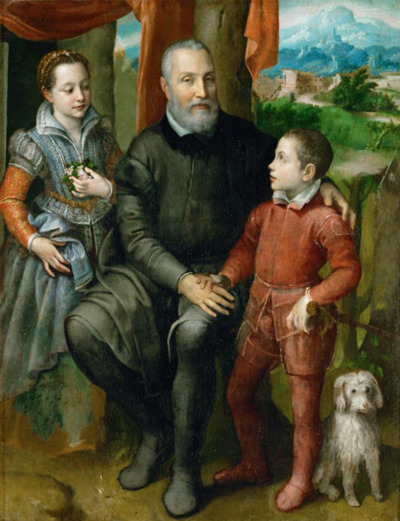
In Sofonisba Anguissola: A Renaissance Woman, Sylvia Ferini-Pagden writes “The linking of the observation of nature with storia, action—the activity being being a fictional one that takes place on the chess board—demonstrates the young artist’s intellectual demands of her medium.”
Chess, she says, was traditionally “the game of the amazons or of maidens in general, as confirmed later by Torquato Tasso, since the queens in the game are allowed the greatest freedom of movement ... In Sofonisba’s painting, two maidens playing a game that is appropriate to their social status are engaged in a debate, on intellectual terrain in which they enjoy equality with men.”
Girl gamers! In play, they can project themselves onto a field of battle or into an academy.
“The disagreement may be about the black queen, gleefully held by Lucia in her left hand, which she has just taken but which perhaps, as in a play written by Marco Gerolamo Vida, Scacchia ludus, in the end will be victorious over the white king.”
Does that make sense, O
![[info]](https://i.gr-assets.com/images/S/compressed.photo.goodreads.com/hostedimages/1380938211i/3404272.gif) nightspore
?
nightspore
?And in looking up Scacchia Ludus, I have discovered Caïssa, the goddess of chess. Fortune smiles.
Nine
* "...pare che spirimo e sieno vivissimi.”
Published on June 16, 2012 17:48
June 15, 2012
A game at chess
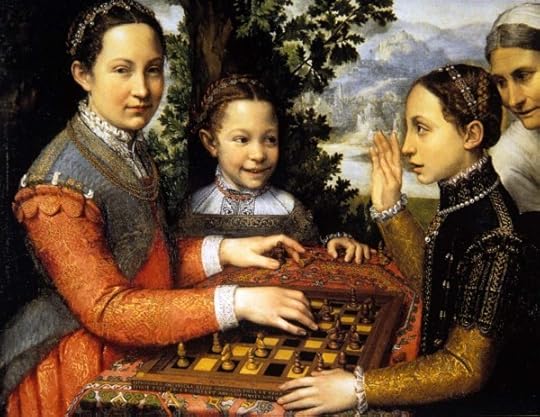
In a Renaissance garden, Lucia, Minerva, and Europa Anguissola play at chess. They delight in one another, in the game. Look at the mischief in that little one’s face! She knows what her sister, all innocence, is up to. The eldest looks out at us, half smiling: she holds some broader strategy in mind. She is born to govern. And the old servant (much loved: she appears in other canvases) looks not at her nurselings but at the board. She sees the mate.
Their sister who painted them has signed the edge of the chess board: Sophonisba Angussola Virgo.
There were six Anguissola sisters—almost a Pleiades—and a little brother, Asdrubale. As the children of a cultured Lombard nobleman, they lived in a little academy, an ivory tower. Oh yes, those clothes are gorgeous, and the hills beyond the garden dreamlike—but it’s the tutelage I envy. They were given masters in music, in languages (that imp Minerva would become a writer and a Latin scholar), and in art.
All of the sisters painted. Lucia, the mistress of the chess game, was brilliant but died young; Anna Maria and Europa gave up their art upon marrying; Elena became a nun. Sofonisba, evading the great scythe, the garland, and the veil, outshone them all. Giorgio Vasari wrote of her: "Anguissola has shown greater application and better grace than any other woman of our age in her endeavors at drawing; she has thus succeeded not only in drawing, coloring and painting from nature, and copying excellently from others, but by herself has created rare and very beautiful paintings.”
At eighteen, she painted her drawing-master painting herself. (Couldn’t decide where that arm should go.)
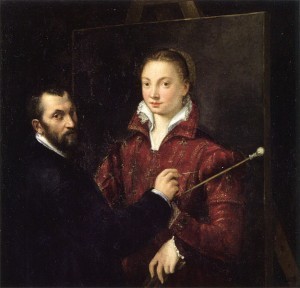
By 23 or 4, she looks out from her easel, in modest command. Close-braided, sober-clad, she has put off her red and gold with her mastery. Virgo: a woman in control of her own life.
In two years, Elizabeth I will ascend the throne.
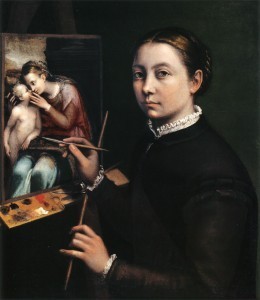
At 27, Anguissola became the court painter to Philip II of Spain and Elisabeth of Valois. Her work was much admired.
After her childbearing years had passed, she chose two husbands: her first at 39, overruling Philip II’s match for her. At 47, widowed recently and sailing homeward to Cremona, she met a much younger man, “the captain of the ship on which she was traveling.” They married and lived happy ever after in a household with a room of her own. “A great love,” he wrote of her.
A privileged life. Serene. Unlike the struggles of so many women artists, far unlike the storm and glare and blood of Artemisia Gentileschi’s later times. No chiarascuro in her history, but a clear light, humanist. No drama. But within the narrow confines of her rule-bound (inlaid) life, she played brilliantly. She studied the board.
Sofonisba lived a very long time, from the later Renaissance into the Baroque. As a young woman, she studied with Michelangelo; as a young man, van Dyck came to see her in Palermo, to pay his respects to the old master, Michelangelo’s last student. Doubtless she gave him good advice. He painted her at 92: still sharp, still powerful. A White Queen on the board.
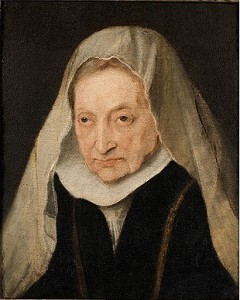
Nine
Published on June 15, 2012 01:44
June 5, 2012
Five by Nine
Five questions set me by
![[info]](https://i.gr-assets.com/images/S/compressed.photo.goodreads.com/hostedimages/1381122786i/4281084.gif) sovay
sovay
1. Which character do you like best that you would never want to meet?
Well, Stalin in Collaborators is a magnificent comic monster, and I wouldn’t want to be on his planet. But “best” is difficult. I would avoid all villains, on the whole, however juicy. I have no desire to meet with several of my own gods either, and I frisk with glee when I’m writing them.
2. What music can you no longer listen to?
Switched-On Bach.
(You may also answer this question in the converse: what do you listen to now that you never thought you would?)
I’ve pretty much stayed folk-Baroque-looney tunes with timid excursions.
3. If you could ask any ghost of your family for a single story, what would it be?
My mother’s father, who died just after I was born, came from Russia to London around 1900. (My mother said he would dance like Stanley Holloway when he felt joyful, pulling up his trouser cuffs and stepping out dapperly.) I would love to ask him what the East End was like before the Great War, and how he learned his trade there as a goldsmith.
4. What book (by another author) would you rewrite?
I don’t rewrite them. I sleave them out into strands and reweave them.
5. What artistic talent do you wish you had and what would you trade to get it?
I’ve wanted to be able to sing like a Waterson since forever; but having just returned from Florence, I’ve been wishing I could paint like Botticelli.
Art is work, if only you have the gift. With another few lives and about a hundred years’ apprenticeship, I could probably hang something in the corner of a provincial museum. That’s where the goldsmith’s genes come in.
What would I would trade for it? Not my writing.
Nine
![[info]](https://i.gr-assets.com/images/S/compressed.photo.goodreads.com/hostedimages/1381122786i/4281084.gif) sovay
sovay
1. Which character do you like best that you would never want to meet?
Well, Stalin in Collaborators is a magnificent comic monster, and I wouldn’t want to be on his planet. But “best” is difficult. I would avoid all villains, on the whole, however juicy. I have no desire to meet with several of my own gods either, and I frisk with glee when I’m writing them.
2. What music can you no longer listen to?
Switched-On Bach.
(You may also answer this question in the converse: what do you listen to now that you never thought you would?)
I’ve pretty much stayed folk-Baroque-looney tunes with timid excursions.
3. If you could ask any ghost of your family for a single story, what would it be?
My mother’s father, who died just after I was born, came from Russia to London around 1900. (My mother said he would dance like Stanley Holloway when he felt joyful, pulling up his trouser cuffs and stepping out dapperly.) I would love to ask him what the East End was like before the Great War, and how he learned his trade there as a goldsmith.
4. What book (by another author) would you rewrite?
I don’t rewrite them. I sleave them out into strands and reweave them.
5. What artistic talent do you wish you had and what would you trade to get it?
I’ve wanted to be able to sing like a Waterson since forever; but having just returned from Florence, I’ve been wishing I could paint like Botticelli.
Art is work, if only you have the gift. With another few lives and about a hundred years’ apprenticeship, I could probably hang something in the corner of a provincial museum. That’s where the goldsmith’s genes come in.
What would I would trade for it? Not my writing.
Nine
Published on June 05, 2012 01:48
May 31, 2012
Time and times (concluded)
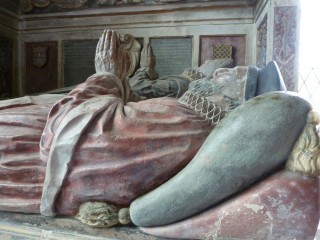
After seeing the stone,
![[info]](https://i.gr-assets.com/images/S/compressed.photo.goodreads.com/hostedimages/1381332803i/4718854.gif) steepholm
and I retired squelching to a pub lunch and a look round the church at Chew Magna. A good ring of bells there, an excellent Elizabethan tomb—its sleepers Christianly composed, assured of green pasturage—and a brass plaque for that irredeemable neo-pagan Giles Lytton Strachey. A pity there’s no monument. Those long long hands cry out for stone.
steepholm
and I retired squelching to a pub lunch and a look round the church at Chew Magna. A good ring of bells there, an excellent Elizabethan tomb—its sleepers Christianly composed, assured of green pasturage—and a brass plaque for that irredeemable neo-pagan Giles Lytton Strachey. A pity there’s no monument. Those long long hands cry out for stone.As in most Anglican churches, there is a board listing the incumbent vicars, back to first records of the parish. Besides the names and dates, this one gives each vicar’s patron and how his tenure was vacated—usually per mort, though one was deprived by Queen Mary and his three successors resigned. The year 1643 was striking:
Incumbent How Vacated Patron
Robert Joyner Dispossessed John Amory
Stubbs—A Preacher The Mob
Robert Cross Commissioners of the Great Seal
Having begun it the night before with
![[info]](https://i.gr-assets.com/images/S/compressed.photo.goodreads.com/hostedimages/1381332803i/4718854.gif) steepholm
's other guest, a scholar of medieval Welsh, we were hoping to finish watching The Owl Service (1969). I’ve wanted to see that ever since 1975 in Cambridge, when I heard Alan Garner rant. As I recall it, he was glittering mad. He seemed to feel dispossessed by the boy who played his character, Gwyn.
steepholm
's other guest, a scholar of medieval Welsh, we were hoping to finish watching The Owl Service (1969). I’ve wanted to see that ever since 1975 in Cambridge, when I heard Alan Garner rant. As I recall it, he was glittering mad. He seemed to feel dispossessed by the boy who played his character, Gwyn.Anyway, we got through about two-thirds of it. O my. I’ll bet that haunted some dreams.
(Later in Florence I saw cut and folded paper owls, very much to Alison’s pattern. Hand-marbled Florentine paper, and alas! quite dear: so I admired and sighed and went on.)
On the way to the airport,
![[info]](https://i.gr-assets.com/images/S/compressed.photo.goodreads.com/hostedimages/1381332803i/4718854.gif) steepholm
(ever the family archivist) handed me an old letter to read. O my O my. Some years ago Garner wrote a poem—an elegy, a celebration—on the late glorious David Munrow; he wanted
steepholm
(ever the family archivist) handed me an old letter to read. O my O my. Some years ago Garner wrote a poem—an elegy, a celebration—on the late glorious David Munrow; he wanted
![[info]](https://i.gr-assets.com/images/S/compressed.photo.goodreads.com/hostedimages/1381332803i/4718854.gif) steepholm
’s brother the composer to set it. A lovely lost undertaking.
steepholm
’s brother the composer to set it. A lovely lost undertaking.Nine
Published on May 31, 2012 22:54
Greer Gilman's Blog
- Greer Gilman's profile
- 42 followers
Greer Gilman isn't a Goodreads Author
(yet),
but they
do have a blog,
so here are some recent posts imported from
their feed.



